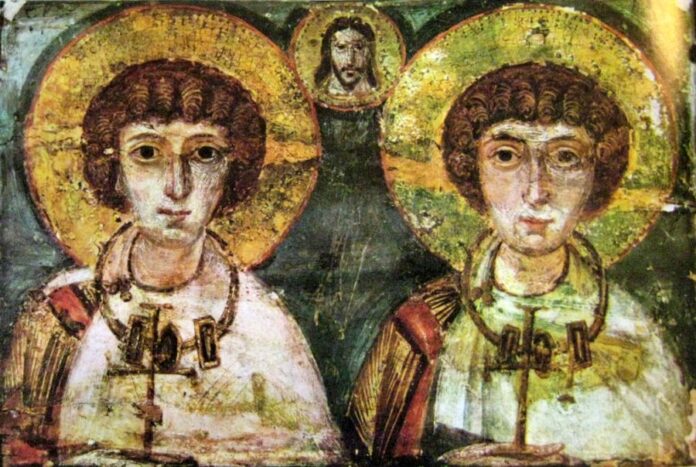Don Basilio Petrà, a professor of the Alphonsian Academy, in the blog article, offers a reflection on the rite of adelphopoiesis in the Eastern tradition and examines whether it is reasonable to see in this case an analogy with the blessing of homosexual couples.
When the Declaration Fiducia Supplicans came out with its indication that it is possible “to bless couples in irregular situations and same-sex couples, without officially validating their status or modifying in any way the perennial teaching of the Church on marriage” (Presentation of Cardinal Fernandez), some have thought of an analogy with the practice of adelphopoiesis (or brotherhood) present especially – but not only – in the eastern tradition.
What sparked this thought is undoubtedly the reference to the blessing of “same-sex couples.” Since 1994, in fact, the term adelphopoiesis immediately brings to mind a religiously sanctioned homosexual union since in that year – the year of his death – John Boswell published the famous and controversial volume Same-Sex Unions In Premodern Europe. In it the Yale historian believed he had shown that adelphopoiesis could be considered a same-sex union ritual. This is what he wrote in his Epilogue, in fact, responding to some critical observations already received: “I replied that I did not compose the same-sex union ceremony which seems to take place in parallel with heterosexual marriage, I only discovered it and how historian I felt the duty to share this discovery.” Boswell’s theses have been much contested, although no one disputes that such ceremonies could have been “abused” in a homosexual context. For some, their fall into disuse may have been facilitated by such abuse.
Boswell is not the only author who brought attention to the rituals of adelphopoiesis during the 20th century. In fact, at the beginning of the century, he was talked about in a famous work by Pavel Florenskij (1882-1937) or in The Pillar and the Foundation of Truth. Essay on Orthodox theodicy in twelve letters (1914), precisely in the eleventh letter dedicated to Friendship. In this letter, at a certain point, Florenskij draws attention to brotherhood both as a “natural sacrament” (as he calls it, asking for the reader’s forgiveness) and as akolouthia eis adelphopoiesin or liturgical rite of brotherhood. He talks about it in the letter on Friendship because he considers brotherhood a “strengthening” of friendship. In this context, he stops to recall the 10 fundamental moments of the “sacred rite of brotherhood,” with at the center “the communion of the brothers, with the holy oblates, with the chalice of the Mass,” which is followed by the conduction of the two hand in the hand around the lectern and the exchange of a kiss. At no time, however, does Florenskij speak of a sexual communion of brothers, rather he writes very precise words that point to his lack of principle: “marriage is two in one flesh and friendship is two in one soul. Marriage is unicarnality – monosarkia – and friendship is unanimity homopsychia.”
Between the idea of Florenskij, who thinks of adelphopoiesis as a sort of sacramental celebration of friendship, and that of Boswell, who instead sees it as a form of ecclesial recognition of the homosexual sentimental union, there is a certain distance, naturally, but there is no lack of points of contact. For both, in fact, they are ritual practices that assume in the Church the emotional bond of two people of the same sex and in some way consecrate it. Furthermore, for both there are de facto analogies with the celebration of sacramental marriage.
What I have just said allows us to measure the distance that, in any case, exists between the tradition of adelphopoiesis and the blessing provided by Fiducia Supplicans, which is indicated as a “pastoral” and non-ritual blessing. This point is strongly underlined in the press release regarding the receipt of Fiducia Supplicans at no.6 where it is said that “to be clearly distinguished from liturgical or ritualized blessings, ‘pastoral’ blessings must above all be very short. These are blessings lasting a few seconds, without a ritual and without a blessing.” Furthermore, in the same place, the Statement insists on the fact that with this blessing given to two people of the same sex, “we ask the Lord for peace, health and other goods for these two people who request it” as well as “that they may live the Gospel of Christ in full faithfulness and that the Holy Spirit can free these two people from everything that does not correspond to his divine will and from everything that requires purification.”
As can be seen, the blessing of Fiducia Supplicans is essentially a very short prayer/gesture of blessing not oriented towards union; adelphopoiesis, on the other hand, is a true ritual; it is a true akolouthia, more or less articulated, oriented towards union, although non-sexual. In the latter, the prayer on the two is extensive, with biblical references, with the invocation of the saints, first of all, the Virgin Mary, in order to establish the fraternal bond between the two, “not by nature, but by faith,” as they say in the Barberini gr. Manuscript 336. “Grant them to love one another, grant that their brotherhood may be without hatred and without scandal all the days of their lives….”
Don Basilio Petrà
Some sources of reference:
J. Boswell, Same-Sex unions in Premodern Unions, Vintage Books, New York 1995, 281.
PA Florenskij, The Pillar, and Foundation of Truth. Essay on Orthodox theodicy in twelve letters, edited by Natalino Valentini, Edizioni San Paolo, 2010, 463-466.
S. Parenti – E. Velkovska (ed.), L’Eucologio Barberini g. 336 (ff. 1-263) , CLV, Rome 1995, 229-230.






